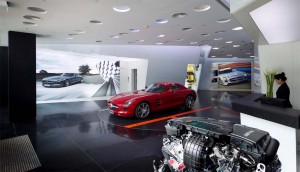Demand for luxury vehicles in China will make it the world’s second-largest market for expensive vehicles by 2016, and number one by decade’s end when it will likely surpass the U.S., according to a new study by the consulting firm of McKinsey & Co.
But industry analysts and planners caution that several obstacles could delay or completely short-circuit the boom in automotive demand in China, both on the mainstream and luxury level.
Sales of premium vehicles will probably equal that of all of Western Europe by 2020, as incomes continue to rise in what is now the world’s second-largest economy, according to McKinsey & Co. China is already the largest automotive market in the world overall.
Deliveries of upscale autos will probably climb to 2.25 million by 2016, according to McKinsey’s estimates, and will reach 3 million by 2020. That compares with luxury vehicle sales of 1.25 million last year, McKinsey said in the new report. The growth rate is expected to significantly outpace that of the total Chinese market.
Increased income levels clearly will help, as will the general aspirations of Chinese consumers who, until relatively recently, were barred from owning luxury goods. Also driving the surge is the expanded presence of luxury makers.
General Motors recently began production of the Cadillac XTS in Shanghai and expects sales by the Caddy brand in China to reach 100,000 units by 2015. Virtually all major high-line brands, such as Mercedes-Benz and BMW are already operating in the country. And new makers are looking for access.
“We expect it to become our number one market,” said Victor Muller, founder and chairman of little, Dutch-based Spyker Cars, which introduced plans for new products and global growth during a preview at the Geneva Motor Show this week.
Ford Motor Co. plans to start sales of its Lincoln nameplate in China next year, while PSA Peugeot Citroen is readying its flagship DS dealership in Shanghai, according to the report.
Nissan considers China so important that it recently set up new headquarters for the luxury brand in Hong Kong. It will try to challenge German marques, led by Audi, which account for about 80% of the highline segment, according to McKinsey.
(Mercedes opens the world’s first standalone AMG dealer. Click Here for that story.
“Even now, China’s premium car market presents a sizable opportunity for latecomers,” authors Sha Sha, Theodore Huang and Erwin Gabardi wrote in the McKinsey report. “Japanese and U.S. attackers still have a chance to create a market footprint.”
Luxury car sales have increased 36% annually in the past decade, compared with the 26% rate for the total passenger vehicle market, according to McKinsey. The segment remains attractive for automakers as 111 large Chinese cities still don’t have premium car dealerships, says a separate analysis by Morgan Stanley & Co.
In its survey of Chinese consumers, 59% of respondents said they won’t choose a local brand when buying premium vehicles, while 16% believe a Chinese automaker will never be able to produce a luxury model that garners global recognition.
Can the luxury market meet the lofty expectations set out by McKinsey and others?
The Chinese government announced it has targeted GDP growth of 7.5% for this year, unchanged from 2012, as the annual parliamentary session opened this week. The country also set a lower inflation goal of 3.5%, aimed at keeping prices in check, according to the forecast in Premier Wen Jiabao’s work report, as he opened the National People’s Congress.
McKinsey noted China’s economy is making its historic shift to a more consumption- and service-driven model that should help sustain the country’s growth, albeit at a slower rate, over the next decade and beyond.
“As November’s 18th congress of the Chinese Communist Party showed, new government policies are helping to move the economy in this direction, even though investment—the historical motor of China’s growth—will still command the lion’s share of the economy in the near term,” the McKinsey analysis noted, adding that the government’s policies should “create more and better-paid jobs and thus raise the share of the national income in the hands of consumers—the key determinant of China’s future economic profile.”
But not everyone is quite so confident. Some skeptics note that demand for luxury vehicles was unsteady last year, forcing makers like Mercedes to enact unexpectedly sharp price cuts to maintain momentum.
As TheDetroitBureau.com reported this past week, there are growing concerns about a slowdown in the automotive market that could follow new efforts to reduce endemic air pollution problems that are steadily worsening in cities like Beijing.
(Could China’s car market go bust? Click Here.)
“They could change policies overnight if they want,” cautioned Spyker’s Muller, and that could bring the overall Chinese car market to a standstill or just slow it down.
The most likely scenario, though, is that regulators will demand automakers switch to battery cars and other clean technologies at an even faster pace than currently mandated. That could play well for some luxury brands, however, as makers ranging from Ferrari to Audi have been introducing new hybrids, plug-ins and full electric vehicles that could meet the new standards.
Paul A. Eisenstein contributed to this report.


No doubt. They are buying up a large portion of the U.S. ~80% of all products sold at Home Depot, K-Mart and Wally World are from China. It’s no surprise that the U.S. has ~20% real unemployment and it’s only going to get worse if we keep buying Chinese goods.
But, Jorge, those unemployed folks can save 15 cents buying batteries at WalMart when their power is turned off!
Paul E.